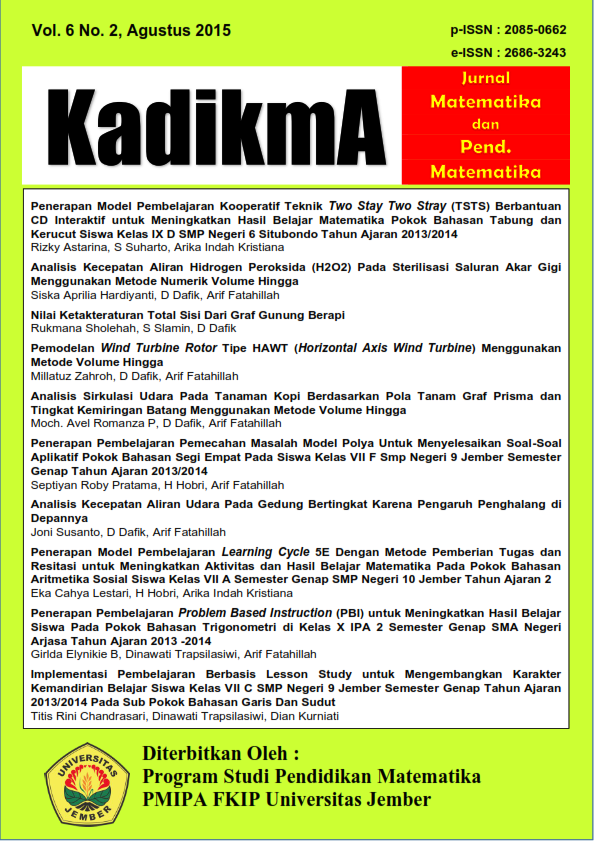PENERAPAN MODEL PEMBELAJARAN KOOPERATIF TEKNIK TWO STAY TWO STRAY (TSTS) BERBANTUAN CD INTERAKTIF UNTUK MENINGKATKAN HASIL BELAJAR MATEMATIKA POKOK BAHASAN TABUNG DAN KERUCUT SISWA KELAS IX D SMP NEGERI 6 SITUBONDO TAHUN AJARAN 2013/2014
Abstract
Abstract. The purpose of two stay two stray method is to make the learning process more effective and improve the focus of students. In general, mathematics learning at schools is still a teacher centered, so the students become less active in teaching learning process. It causes the students become passive, bored, and the low score of the student learning achievement. Therefore, it needs an innovation of learning by applying a cooperative learning two stay two stray method combined interactive cd of cylinder and cone topic to improve the student learning achievement. The research subject is IX D students of SMP Negeri 6 Situbondo. The data collection method used in this research is interview, documentation, observation, and test. The research observed the activity of the teachers and the students. The result shows that the activity of the teachers and the students are significantly increasing in class IX D SMP Negeri 6 Situbondo the improvements of students’ activities are indicated by the average score of 77,26% for the first cycle, 85,73% for the second cycle of the action research. We can conclude that the two stay two stray method combined interactive cd, is efective to improve the student learning achievement in cylinder and cone topic. It is proved by the result of student learning achievement, which is from 48% to 80%.Key Words : cooperative learning two stay two stray, interactive cd, student learning achievement, cylinder and cone.
Published
2015-08-01
How to Cite
ASTARINA, Rizky; SUHARTO, S; KRISTIANA, Arika Indah.
PENERAPAN MODEL PEMBELAJARAN KOOPERATIF TEKNIK TWO STAY TWO STRAY (TSTS) BERBANTUAN CD INTERAKTIF UNTUK MENINGKATKAN HASIL BELAJAR MATEMATIKA POKOK BAHASAN TABUNG DAN KERUCUT SISWA KELAS IX D SMP NEGERI 6 SITUBONDO TAHUN AJARAN 2013/2014.
Kadikma, [S.l.], v. 6, n. 2, aug. 2015.
ISSN 2686-3243.
Available at: <https://jurnal.unej.ac.id/index.php/kadikma/article/view/1980>. Date accessed: 24 nov. 2024.
doi: https://doi.org/10.19184/kdma.v6i2.1980.
Section
Articles


.png)
.gif)





